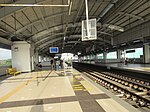De La Salle Araneta University

De La Salle Araneta University, also referred to by its acronym (Araneta U or DLSAU), is a private Catholic Lasallian co-educational basic and higher education institution supervised by the Philippine District of the De La Salle Christian Brothers in Malabon, Metro Manila, Philippines. It was established in 1946 in Bulacan and named Araneta Institute of Agriculture. It was then transferred to the city of Malabon the year after. In 1978 it was renamed the Gregorio Araneta University Foundation. Integration of the university with the DLS System started in 1987 until 2002 when it officially became a member of the system. It is the fifth university in the De La Salle schools network. The university specializes in Veterinary Medicine and Agricultural Sciences. It is a member of De La Salle Philippines, a network of several Lasallian educational institutions within the Lasallian East Asia District.
Excerpt from the Wikipedia article De La Salle Araneta University (License: CC BY-SA 3.0, Authors, Images).De La Salle Araneta University
Victoneta Avenue, Malakalamanga
Geographical coordinates (GPS) Address External links Nearby Places Show on map
Geographical coordinates (GPS)
| Latitude | Longitude |
|---|---|
| N 14.6714 ° | E 120.9986 ° |
Address
De La Salle Araneta University
Victoneta Avenue
1476 Malakalamanga
Philippines
Open on Google Maps






